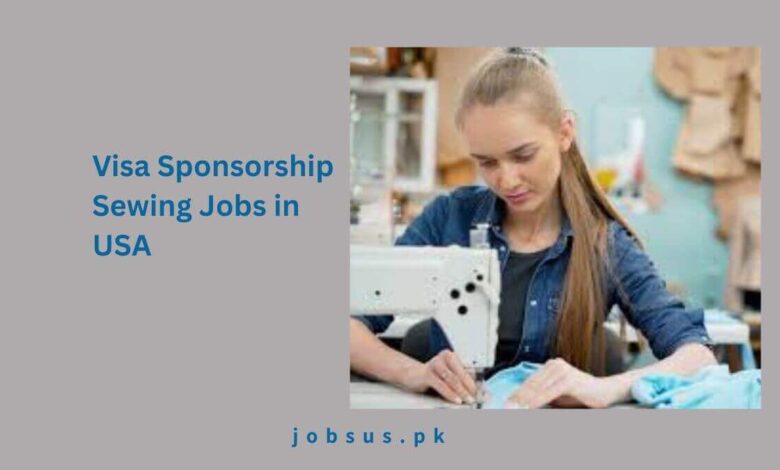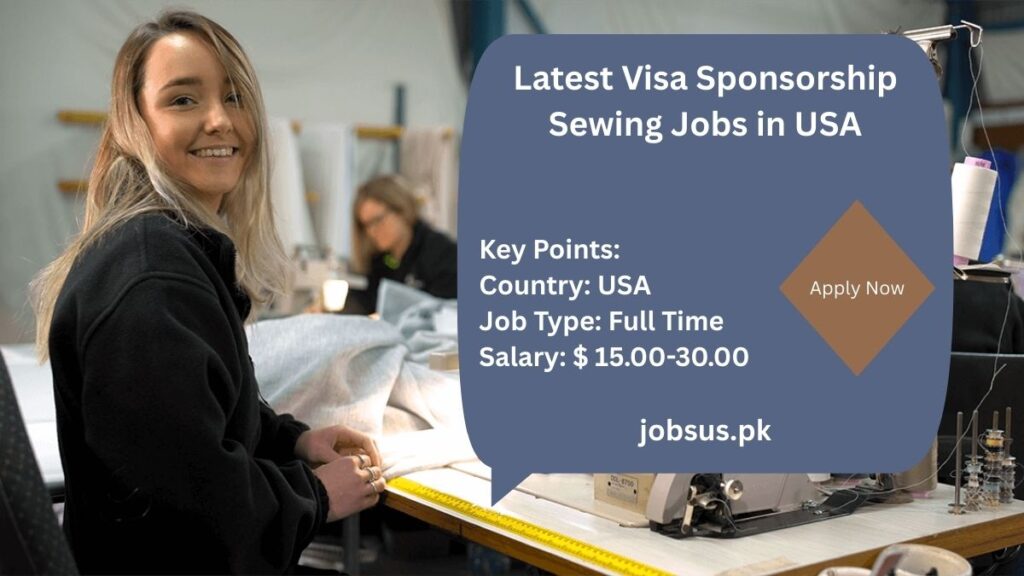Visa Sponsorship Sewing Jobs in USA 2025 | $18.00 Per Hour

The garment and textile manufacturing sectors in the United States are experiencing a robust demand in 2025, which is creating valuable opportunities for skilled sewing professionals worldwide. In order to address labor shortages and increase production, numerous organizations are currently providing visa sponsorship to international candidates.
These sewing positions entail the operation of industrial sewing machines, the repair of fabrics, the stitching of garments, and the maintenance of quality control throughout the production line. In industries such as upholstery, automotive interiors, fashion, and commercial textile production, workers are required.

Job Details:
- Job Title: Sewing Professional (Various Roles)
- Location: United States (Multiple locations depending on employer)
- Visa Sponsorship: Available (H-2B, EB-3, or other relevant work visas)
Requirements:
- Educational Background: The employment of SOC 261 occasionally necessitates a high school diploma or a general equivalency diploma (GED).
- Work experience in the textile industry, fashion design, or stitching may prove advantageous.
- Technical Proficiency: The candidate must possess a comprehensive understanding of the operation of stitching machines, the cutting of materials, and the manipulation of a variety of fabrics. Additionally, it is imperative to be acquainted with measurements, patterns, and modifications.
- Attention to Detail: In sewing positions, particularly those that involve fashion designer wear or made-to-order apparel, the degree of delicacy and closeness of work are crucial.
Benefits:
- Competitive Salary:
Wages of sewing jobs in the USA are normally good with chances for overtime payment rates. Wages may depend on working experience, geographical area, and position of the specific job. - Job Stability:
There is always demand for well-trained and professional sewers especially for fashion and manufacturing industries. This creates job security and gives long-run employment chances to the unique population of women. - Career Growth:
Higher-level jobs that sewing professionals can aspire to include sewing supervisors, pattern makers, or even fashion designers with better and more training. - Health and Retirement Benefits:
Most companies provide medical coverage and pensions and most other benefits some of which are listed below.
Check Also: Visa Sponsorship Laboratory Assistant Jobs in USA– Hiring Guide
Duties:
- Fabric Cutting and Measuring: It is crucial to adhere to the correct cutting and measuring procedures during the production process to ensure that the final product is manufactured to the correct specifications.
- Reading and Following Patterns: In order to manufacture specific textiles or garments, tailors and seamstresses must possess a comprehensive understanding of pattern instructions, layouts, and any other technical drawings.
- Altering Clothing: A variety of sewing jobs necessitate the modification of clothing, including hemming, resizing, or mending garments that have been damaged in some manner.
- Quality Control: Some of the job responsibilities include ensuring that the products are free of defects and that the seams have the appropriate number of stitching, as well as any visible loose threads.
Salary Expectations:
Sewing job remunerations in the USA depend on factors such as; location of work, experience, and the job description in place. On average, sewing professionals can expect to earn:
- Entry-Level Positions: $25,000 to $35,000 annually
- Experienced Sewers: This amount is typically between $35,000 and $50,000 annually.
- Specialized Positions (e.g., Pattern Makers, Tailors): The annual salary ranges from $40,000 to $60,000.
- Supervisory Positions: an annual salary of fifty to seventy thousand US dollars
Types of Jobs:
- A tailor is a professional who creates clothing for specific clients, modifies it by adding or subtracting sizes, and repairs it.
- Seamstress/Seamster: Sewers, tailors, or stitchers who sew and join clothing, accessories, or household textiles.
- Pattern Maker: Pattern makers are responsible for the creation of apparel patterns in accordance with the designer’s vision. They are also engaged in the production and preparation of garments.
- Costume Designer: Specialty costume designers, such as theatrical costume makers and tailors, are responsible for the design and stitching of costumes for stage burlesque, motion pictures, and other events.
- Upholsterer: Sewers are responsible for the fabrication and construction of furniture, transport vehicle seats, and other similar products.
- Embroidery Machine Operator: These employees employ embroidering machines to incorporate detail works, insignia, or brand logo designs into apparel and fashion fabrics.
- Garment Assembler: Garment assemblers are manufacturing laborers who are responsible for the sewing and assembly of garment components or other related accessories.
- Textile Worker: This industry employs a variety of individuals, including weavers, knitters, and spinners, as well as tailors who transform fabrics into practical items and quality controllers.
- Sewing Supervisor: Sewing supervisors are responsible for coordinating sewing sub-groups to ensure that the established production and quality objectives are met.
- Industrial Sewing Machine Operator: These professionals operate industrial sewing machines in a production environment and sew through thick fabrics, such as canvas or leather.
Job Application Process:
- Job search platforms: These platforms include social networks, job search websites, forums, employment-related boards, company websites, and traditional career sites.
- Prepare a Resume and Portfolio: Make a resume for your sewing experience, skills, qualifications, and achievements. If it is feasible, include the portfolio of the most exceptional work completed thus far.
- Apply for Jobs Online: You may submit your resume and cover letter directly through the company’s website, currently available online employment search sites, or employment agencies that specialize in textile and sewing positions.
Frequently Asked Questions:
What kind of work includes sewing?
The sewing industry provides a vast variety of career opportunities in textile production, sales, retail, sewing and manufacturing. Sewing industry jobs can involve the technical development or logistics of textile creation, along with the production and sale of clothing or other fabric items
What is the role of a sewing operator?
A sewing machine operator performs a variety of tasks which may include: operating the sewing machine, loading and unloading, loading and unloading of supplies, preparing and measuring materials, sewing different items, and completing reports.
Are tailors in demand in USA?
Demand for Tailors, Dressmakers, and Custom Sewers is expected to go up, with an expected 14,850 new jobs. This represents an annual increase of 7.91 percent over the next few years.



